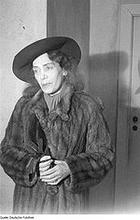
Mary Wigman, artistic name of Karoline Sophie Marie Wiegmann (Hanover, November 13, 1886 - Berlin, September 19, 1973) was a German dancer, principal muse of the expressionist dance. He studied with Rudolf von Laban and had close contacts with the expressionist group Die Brücke, while, during the First World War, he related to the Dadaist group in Zurich. For her, the dance was an expression of the interior of the individual, with special emphasis on the expressiveness of the form. This gave special importance to the gestures, often linked to improvisation, as well as the use of masks to accentuate the expressiveness of the face. His movements were free, spontaneous, trying new ways of moving around the stage, crawling or sliding, or moving parts of the body in a static attitude, as in the oriental dance. It was based on a principle of tension-relaxation, which provided greater dynamism to the movement. She also used the notions of fall-recovery to diagram the possibilities between these two poles, which she considered "deaths" (one of the reasons why her explorations in the movement anchored her in a period of the history of dance. Formalist, but expressionist). It was concretely who began to use stillness as a potential in movement, not as a synonym of silence or emptiness. He created choreographies made entirely without music, while freeing himself from the bonds of space, which instead of wrapping and catching the dancer became a projection of his movement, pursuing that old romantic desire to merge with the universe. He always maintained that the movement is worth more than many words, and he called his production "Absolute Dance", claiming that the dance IS simply.




